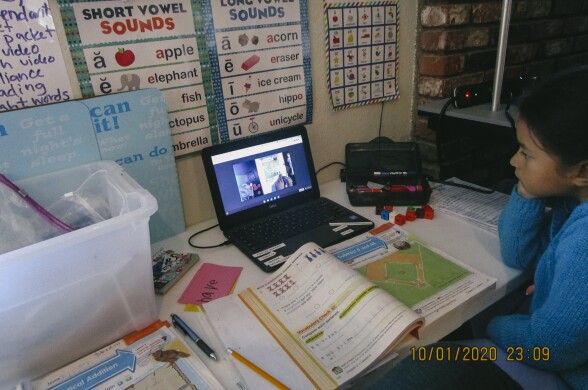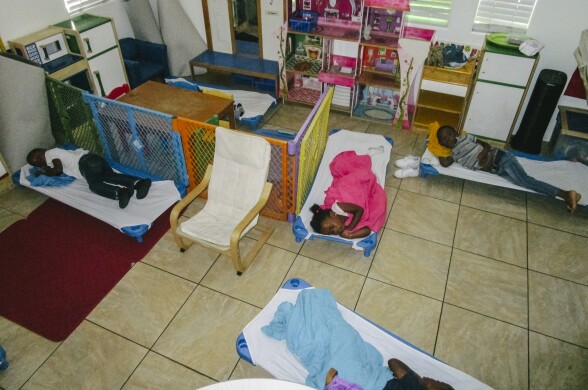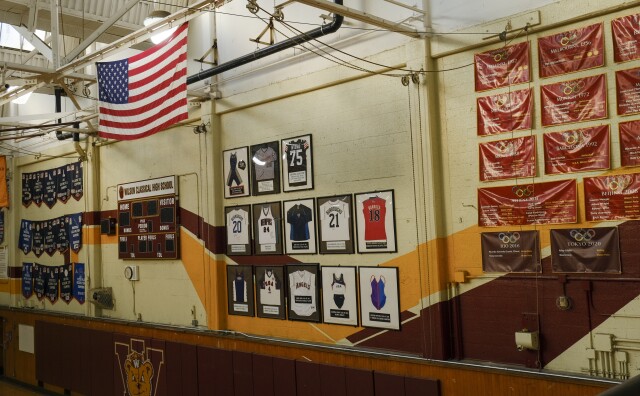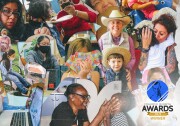Manoja Weerakoon intended on closing the La Habra Montessori preschool she directs when the coronavirus pandemic hit California.
“I had to think about the children. I had to think about my staff,” Manoja says. “I had to think about my family, my health.”

But a handful of her students’ parents are essential workers, including people who work in health care, and single parents. They told her they didn’t have anywhere else to take their children.
Manoja’s preschool stayed open and fully staffed with the help of donated cleaning supplies, plastic panda bear face shields, and new rules for the kids, including daily temperature checks.
"We had to put [on] this front: 'OK, we know what we are doing. We are brave,'" Manoja says. "But we were not. We were scared."
From the beginning, California leaders urged child care providers to stay open for essential workers.
-
We gave cameras to 12 Southern California child care providers, educators and caregivers and asked them to document their lives starting in the summer of 2020.
-
Join a live virtual event on June 17 and see the photos in real life at a series of photography installations throughout the region.
Providers swamped the conference calls held by the state’s licensing agency to explain sometimes-vague new safety guidelines, including how to “enhance cleaning” or “implement staggered outdoor or large group times.”
Initially, Montebello family child care provider Susana Alonzo closed down her business. She described it as a heart-wrenching decision.
Susana didn’t feel like she could give families the security and protection they needed at the beginning of the pandemic. Thinking about what her clients would do without her, “me sentía emocionalmente mal,” she says. Emotionally, she felt awful.

Susana eventually reopened her family child care with some big changes — children older than 2 would wear a mask and, unless seated with siblings, kids would sit at desks divided by clear plastic.
The Center for the Study of Child Care Employment surveyed California providers last summer, and 80% reported it cost more than usual to operate their facilities because of the cost of protective gear and cleaning supplies.

Safety measures also meant the children could not run around or visit the park like they’d done before, or even play together.
“What child likes to play alone?” Susana asks out loud in Spanish. She answers her own question. “No one — a ninguno.”

All the providers we talked to changed how they care for children to prevent the spread of COVID-19, but they have learned that it’s nearly impossible to keep young kids masked and six feet apart 100% of the time.
“Children, they love to hug you, they like to be social and stay close to us, stay close to each other,” says Brenda Cruz, a teacher at Saint John’s Providence Early Childhood Directions program.
-
Share a photo and your story with the hashtag #childcareunfiltered. We may even feature some of your community stories on LAist throughout the summer.
Before the pandemic, dozens of children and staff would fan out across the playground at the Santa Monica child care center for recess, filling the air with a chorus of shouts. Now, they’re limited to playing one group at a time.
“They try their best to keep themselves a little distanced, but it doesn’t always happen that way,” Brenda says.
That’s not to say the children haven’t adapted. Brenda sometimes overhears the kids reminding each other — and their teachers — about the new rules.

We know now that there have been few outbreaks of COVID-19 among kids or adults linked to child care settings.
“When those child care providers continued going to work taking care of our children, they didn’t know that,” says Yale child psychiatry and psychology professor Walter Gilliam. “They did it anyway, because they knew that somebody had to take care of the kids.”
Gilliam and his Yale colleagues surveyed child care workers and found that those providers who continued to work during the pandemic were not more likely to contract COVID-19 than providers who shut down. The study took in the responses of more than 57,000 child care workers.
While COVID-19 cases surged in Southern California last December, L.A. County Public Health Director Barbara Ferrer said in a press conference that child care providers had done an “amazing job for many, many months, taking care of small children, young children, and using a lot of safety, and there have been very, very few cases.”
Only a fraction of the more than 7,000 licensed child care homes and centers in L.A. County recorded confirmed cases.
Though child care centers and homes remained fairly safe, the child care workforce — which, in Los Angeles County is majority Latino — often went home to the communities hardest hit by the pandemic.
Even the possibility of a COVID-19 exposure led some child care programs to close for weeks, or at least until a negative test came back.

One day last October, Susana’s home child care was empty after she learned there was a chance she and the families in her care had been exposed to COVID-19 by a parent. She’d developed a dry cough and a temperature, and she got worried.
Waiting to find out whether she and others had been exposed was a stressful time, Susana recalls. “¿Estaremos enfermos o no estaremos enfermos?” she wondered. Would they be sick or not?
The doctor determined she had bronchitis, not the coronavirus. But two months later the dry cough returned, along with body aches and fatigue. This time, she tested positive for COVID-19.
Though she didn’t experience shortness of breath or more serious symptoms, Susana isolated herself from the day care center and her own family. Instead of toasting and opening presents at midnight on Christmas Day, they had to celebrate over Zoom.
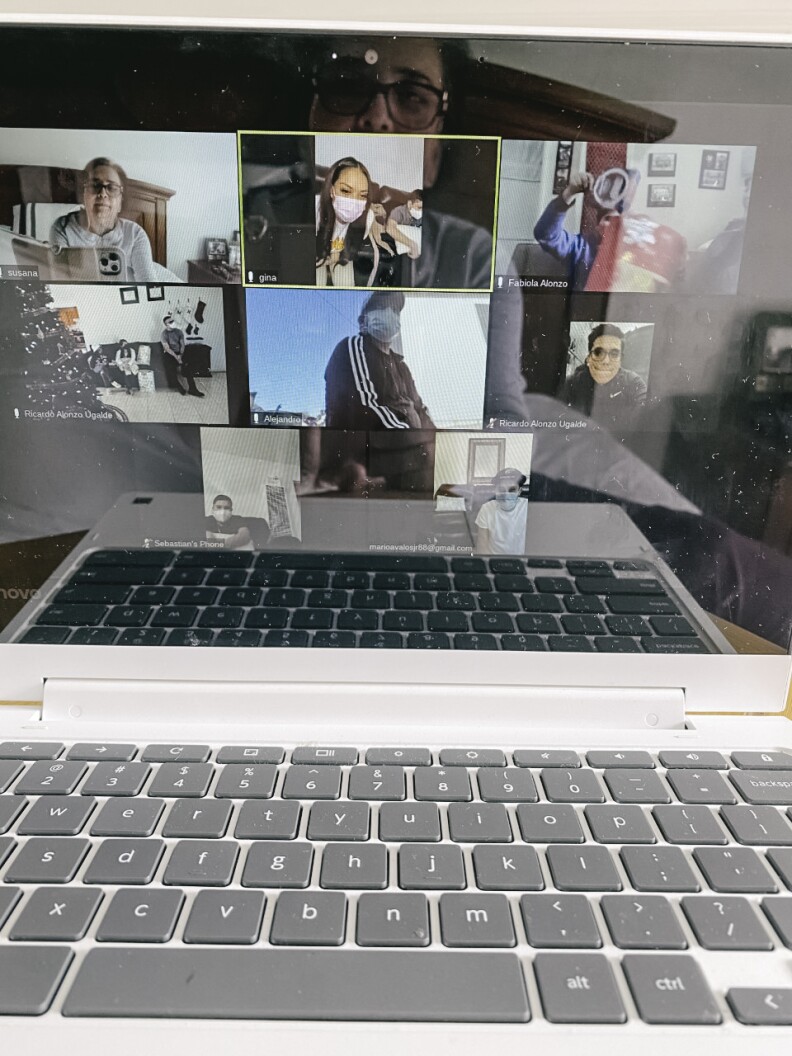
“We knew we were together,” she says. “That’s the most important thing. Separate, but together.” She adds: “But it wasn’t the same.”

Luz Hernández draws on nearly two decades of experience as a teacher in Mexico when she cares for two of her granddaughters, ages 3 and 4, along with children who live near her Koreatown apartment.
She makes a little bit of money, but she mostly enjoys working with the children, helping them learn to walk, talk (say "Thank you!"), and recognize letters and numbers.
In December, Luz and her husband, Gil, were both diagnosed with COVID-19. She recovered, but Gil was hospitalized on New Year’s Eve.
“He said it was temporary, that he was getting better,” Luz says in Spanish. “But no, it wasn’t like that.”
She remembers the doctors speaking bluntly: “Your husband is going to die.” Just like that, she says, “with those words.”

Gil passed away on January 29.

Luz is still trying to wrap her head around the loss, let alone explain it to her granddaughters.
It’s difficult to explain the situation to them, Luz says, “porque ni yo puedo entenderlo.” Because, she says, she can hardly understand it herself.
Gil was the family breadwinner. His job packing food at a meal subscription company provided for Luz and her teenage daughter, Kimberly.

She hasn’t been able to pay rent since March.
Luz says they can’t sit idly by, though she’s not sure what to do — perhaps make and sell food? She says she’ll have to come up with something.
Luz’s granddaughters still pretend to talk with their abuelo, asking, “Estás bien?” Are you OK? Nothing hurts anymore?
They pick up his larger-than-life-sized portrait and dance around the living room, surrounded by the periwinkle blue walls he loved.
Four-year-old Valeria tells Luz not to be sad, because her abuelo is taking care of her.
Life goes on.

Research from the University of Southern California found that during the pandemic there’s been a 20% increase in children who’ve lost at least one parent, compared to a typical year. Of the 37,000 to 43,000 kids affected, one in four were younger than 10 years old.
In the coming months and years, child care providers will play a part in how those kids process their feelings about the loss of parents and other family members.
South Central family child care provider Jackie Jackson says the loss manifests itself in different ways.
One boy was having a hard time falling asleep at naptime, thinking about the recent death of his grandfather. She sat with him, singing, patting his back, and bundling him up in a cocoon of blankets.
“I told him, he’s gonna be a beautiful, handsome butterfly...when he wakes up,” Jackie says.

Some family child care homes, which largely remained open during the pandemic, became miniature schools where children learning online had a place to go while their parents worked — and safe havens for families who trusted their children would be protected in a small group setting.

Jeanne Yu remembers this advice from a representative of California’s child care licensing agency when she first opened a Gardena home-based child care in 2005: “Even though there is no requirement of having so much space, you want to have an area where it’s just family.”
This summer, that personal family space — her living room — was converted into a pod for distance learning, where school-age children in her care sat socially distanced with their headphones, iPads and computers.
During breaks she could hear them laughing, singing and dancing.
“There’s a sense of normalcy,” Jeanne says. “They know ‘OK, we’re in class,’ but they’re not alone. They can do it with friends.”
When public early education programs and private child care centers closed during the pandemic, teachers scrambled to adapt the very hands-on work of early childhood education to the virtual space.
“Ever since we stopped going back to school, it was just something like...they cut our wings,” says Maria Gutierrez, who teaches at Los Angeles Unified School District early education centers.

Maria transformed one side of her grandson’s bedroom into a virtual classroom.
An alphabet banner lined the wall. Brightly colored construction paper props with shapes and numbers were hung with masking tape, ready for her to pull down and show the students on the other side of the camera.
Maria opened each lesson with a good morning song, attendance and a question. “What kind of animals are wild animals? What kind of animals are pets?” she asked one morning in early March. She recruited her grandson’s colorful stuffed monkeys (wild animals!) to help illustrate the lesson.
“We have to make sure that they are having fun too. Because through play, the children learn,” Maria says.
But sometimes instead of little faces, she’d see black boxes on the screen. Maria says some students were too shy to turn on their cameras during their Zoom sessions. On a few occasions, the kids would have masks on because someone else in their house was sick with COVID-19.
“I learned to be more empathetic, I learned to be more understanding. I learned to be patient,” Maria says. She delivered food from her own fridge and pantry to one family after the mom told her they didn’t have anything to eat.

Early Head Start teacher Ruth Flores set up her virtual classroom on a tiny part of the wall facing the bathroom in the studio apartment in Mid-City where her family has lived for more than 40 years. At one point, she, her three siblings, and her parents all lived in the apartment. Now she shares it with her mother, who she drives to work every morning before the school day begins.

“How do we teach online? Because we weren’t taught that in school,” Ruth says. “Nobody taught us; we have to be learning it from scratch.”
She tacked a sprawling paper tree on the wall and changed out the decorations for each season.
“Just the process of knowing that I’m going to make the kids happy just makes me happy, too,” Ruth says.
There was also a new sense of loneliness teaching 2- and 3-year-olds from her computer.
“I miss those hugs,” Ruth says. “If you hear them cry, you wish you could give them a hug, but you can’t.”

Both nannies who took photos for this project were let go by the families they worked with almost immediately at the start of the pandemic.
“You don’t realize how much joy they bring into your life, until it’s taken away,” says Sofi Villalpando, a nanny in the San Fernando Valley’s North Hills neighborhood.
Sofi estimates she made less than half of the money she’d count on in a typical year because she also had to cancel Camp Snowflake, the annual summer program she runs for kids.
“I’ve never been so terrified when I’m working with kids because it’s always been so natural,” Sofi says. “You know how to protect them, and know how to nurture them.”
Her client family called her back to work in May, largely to help with virtual learning for Leo, now 6.
The pair breaks up hours of online instruction with lightsaber battles and “fast parties,” her name for 10-minute interludes of whatever Leo wants to do.
“I think about the times when I was just laying in bed and thinking, ‘Oh my God, the world is ending out there. What is going on?’” Sofi says. “I’m just grateful. I’m just grateful to be working.”













